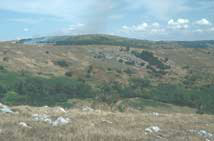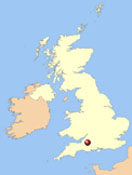
HOME · INDEX · THOMAS MINOR · 2nd GENERATION · 3rd GENERATION · 4th GENERATION · 5th GENERATION · 6th GENERATION · CITATIONS

HOME
·
INDEX
·
THOMAS MINOR
·
2nd GENERATION
·
3rd GENERATION
·
4th GENERATION
·
5th GENERATION
·
6th GENERATION
·
CITATIONS
In the early days it was enough for the common man to be identified by a single name. In England during the 1300's, the time of Chaucer, first names were no longer enough and family surnames came into use. Some were simply the suffix 'son' as in Johnson. People also became identified with where they lived and what they did. The Miner family of Chew Magna could have descended from someone whose name originated from an association with mining in the nearby Mendip Hills area.
 The Mendip Hills are a range
of limestone hills in the northern part of the county Somerset, England.
They are situated to the south of Bristol and Bath, and they run east to west between
Weston-super-Mare and Frome. The Mendips overlook the Somerset Levels to the south and the
Avon and Chew valleys to the north. They are composed largely beds of Carboniferous limestone
originating as sediment from aquatic life laid down in a warm shallow sea 300 million years ago.
Limestone is a sedimentary rock composed
largely of the mineral calcite.
The Mendip Hills are a range
of limestone hills in the northern part of the county Somerset, England.
They are situated to the south of Bristol and Bath, and they run east to west between
Weston-super-Mare and Frome. The Mendips overlook the Somerset Levels to the south and the
Avon and Chew valleys to the north. They are composed largely beds of Carboniferous limestone
originating as sediment from aquatic life laid down in a warm shallow sea 300 million years ago.
Limestone is a sedimentary rock composed
largely of the mineral calcite.
In some areas the limestone has been mineralized with metal ores deposited as vertical
veins in the faults. The Mendip Hills had rich veins of
lead running just beneath the surface
in seams. These seams were dug out and then dug up again over generations as machinery and techniques
improved. This activity has led to the industrial wasteland or gruffy ground of lumps,
bumps and rock outcrops that you may see today.
 Lead-mining took place in Britain before the Roman invasion and archaeological remains of mining
occur in the Mendip Hills in Somerset, Devon, Cornwall, the Pennines, and Wales. Demand for lead
grew during the Roman period when the metal was used for various purposes including making
water-pipes. Much of the attraction of the lead mines may have been their silver content.
Lead-mining took place in Britain before the Roman invasion and archaeological remains of mining
occur in the Mendip Hills in Somerset, Devon, Cornwall, the Pennines, and Wales. Demand for lead
grew during the Roman period when the metal was used for various purposes including making
water-pipes. Much of the attraction of the lead mines may have been their silver content.
Lead mining revived in the 12th century, but was an insignificant source of wealth
when compared with the development of a prosperous clothing industry in the surrounding
villages and towns. After about 1670, the lead industry began to decline but revived
in the mid 19th century when the rock dumps were re-worked. Much of the present evidence
of mining dates from that period. Mining in England dwindled rapidly in importance after 1850
when cheaper supplies of lead from overseas became available.
Updated 16 December 2016.